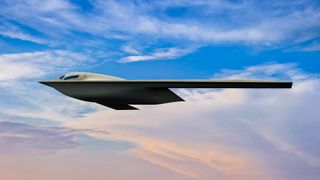US Air Force unveils new B-21 Raider stealth bomber today. Here's what we know
The plane has been described as "the most advanced military aircraft ever built."

The U.S. Air Force will unveil its new B-21 Raider stealth bomber today (Dec. 2).
The B-21 Raider is the Air Force's first new bomber in over 30 years and has been called "the most advanced military aircraft ever built" by its manufacturer, Northrop Grumman. While the stealthy jet will be revealed at the invite-only, tightly controlled event, the aircraft isn't expected to make its first flight until 2023, according to statements by an Air Force spokesperson given to Air Force Magazine.
The B-21 Raider will be unveiled at a ceremony at Northrop Grumman's facility in Palmdale, California on Friday (Dec. 2) at 8:00 p.m. EST (0100 GMT on Dec. 3). You can watch the ceremony live on YouTube courtesy of Edwards Air Force Base.
Related: X-37B: The Air Force's mysterious space plane
The B-21 Raider has been described by Northrop Grumman as the "world's first sixth-generation aircraft," a term that describes its level of technological sophistication relative to other craft. While the definition of what makes a sixth-generation aircraft is still being refined, the B-21 nonetheless stands above other production aircraft in terms of its digital capabilities and its ability to operate in either crewed or uncrewed operations. The bomber will be capable of deploying both nuclear and conventional weapons.
Much remains unknown about the B-21's capabilities, and this will likely be the case for some years to come even after the jet makes its first flight. Nonetheless, there have been some details released to the public ahead of its unveiling. According to a Northrop Grumman fact sheet released on Nov. 29, the B-21 will feature "advanced networking capabilities," which likely means that the stealth bomber will be able to coordinate and communicate with other assets including satellites, ground stations and other aircraft that might even include uncrewed long-distance "wingman drones" designed specifically for the B-21.

The most revolutionary feature of the B-21 Raider will likely be its stealth capabilities. Stealth technologies are among some of the most sensitive and classified in the U.S. military's arsenal, so not much is known about the exact stealth systems the bomber will have. For its part, Northrop Grumman has stated simply that that the company is "continuously advancing technology, employing new manufacturing techniques and materials to ensure the B-21 will defeat the anti-access, area-denial systems it will face."
Get the Space.com Newsletter
Breaking space news, the latest updates on rocket launches, skywatching events and more!
Much of the B-21's sophistication comes in the form of the software used both in the aircraft itself and in its manufacturing process. Its maker describes it as a "digital bomber" in that much of its design and manufacturing was performed using a software-based "digital twin" to help reduce production costs.
In addition, the Raider will feature an open software architecture that will allow seamless integration of upgraded technologies and capabilities in the future.
The B-21 Raider was named after the daring April 1942 raid on Japan led by Lt. Col. James "Jimmy” Doolittle, which helped turn the tide of the Pacific theater in favor of the allied forces during World War Two.
Northrop Grumman currently has six B-21s in various stages of assembly and testing at its Palmdale plant. The Air Force has estimated that each nuclear-capable B-21 Raider will cost roughly $692 million to procure.
Follow Brett on Twitter at @bretttingley. Follow us on Twitter @Spacedotcom or on Facebook.
Join our Space Forums to keep talking space on the latest missions, night sky and more! And if you have a news tip, correction or comment, let us know at: community@space.com.

Brett is curious about emerging aerospace technologies, alternative launch concepts, military space developments and uncrewed aircraft systems. Brett's work has appeared on Scientific American, The War Zone, Popular Science, the History Channel, Science Discovery and more. Brett has English degrees from Clemson University and the University of North Carolina at Charlotte. In his free time, Brett enjoys skywatching throughout the dark skies of the Appalachian mountains.
